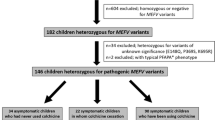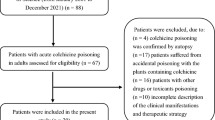Abstract
Familial Mediterranean fever is a hereditary disease, characterized by recurrent episodes of inflammation. Colchicine, the mainstay of therapy, is administered continuously to all diagnosed FMF patients. Drug–drug interaction between colchicine and clarithromycin, resulting in colchicine intoxication, has been noted, mainly in association with gout and pneumonia. In FMF, this adverse event has been scarcely described. We present and characterize six patients with clarithromycin-related colchicine intoxication, aiming mainly at characterizing the FMF-specific features of this event. This study is a retrospective analysis, based on clinical and hospital records of all FMF patients admitted to one hospital during 2002–2015, for colchicine intoxication, precipitated by consumption of clarithromycin. All six patients were women who received colchicine for FMF, and clarithromycin for Helicobacter pylori (HBP) gastric infection. Their daily dosages of colchicine ranged from 1.5 to 2.5 mg. Two had mild FMF, two moderate and two severe diseases. Colchicine intoxication occurred despite intact kidney function and was characterized by abdominal pain, diarrhea, weakness, rhabdomyolysis, hepatitis, kidney impairment and bone marrow injury. It is concluded that clarithromycin-induced colchicine intoxication is a hazard in FMF. It occurs despite normal kidney function and standard colchicine dose and is associated with female sex and moderate to severe FMF.
Similar content being viewed by others
References
Almeida de Jesus A, Goldbach-Mansky R (2013) Monogenic autoinflammatory diseases: concept and clinical manifestations. Clin Immunol 147:155–174
Touitou I, Koné-Paut I (2008) Autoinflammatory diseases. Best Pract Res Clin Rheumatol 22:811–829
Yang J, Xu H, Shao F (2014) Immunological function of familial Mediterranean fever disease protein pyrin. Sci China Life Sci 57:1156–1161
Ozen S, Demirkaya E, Erer B, Livneh A, Ben-Chetrit E, Giancane G et al (2016) EULAR recommendations for the management of familial Mediterranean fever. Ann Rheum Dis 75:644–651
Terkeltaub RA (2009) Colchicine update: 2008. Semin Arthritis Rheum 38:411–419
Terkeltaub RA, Furst DE, Digiacinto JL, Kook KA, Davis MW (2011) Novel evidence-based colchicine dose-reduction algorithm to predict and prevent colchicine toxicity in the presence of cytochrome P450 3A4/P-glycoprotein inhibitors. Arthritis Rheum 63:2226–2237
Declèves X, Chappey O, Boval B, Niel E, Scherrmann JM (1998) P-glycoprotein is more efficient at limiting uptake than inducing efflux of colchicine and vinblastine in HL-60 cells. Pharm Res 15:712–718
Cisternino S, Rousselle C, Debray M, Scherrmann JM (2004) In situ transport of vinblastine and selected P-glycoprotein substrates: implications for drug–drug interactions at the mouse blood–brain barrier. Pharm Res 21:1382–1389
Food and Drug Administration (2009) Information for healthcare professionals: new safety information for colchicine (marketed as colcrys). http://www.fda.gov/Drugs/DrugSafety/ Accessed 2009
Dogukan A, Oymak FS, Taskapan H, Güven M, Tokgoz B, Utas C (2001) Acute fatal colchicine intoxication in a patient on continuous ambulatory peritoneal dialysis (CAPD). Possible role of clarithromycin administration. Clin Nephrol 55:181–182
Akdag I, Ersoy A, Kahvecioglu S, Gullulu M, Dilek K (2006) Acute colchicine intoxication during clarithromycin administration in patients with chronic renal failure. J Nephrol 19:515–517
Mor A, Shinar Y, Zaks N, Langevitz P, Chetrit A, Shtrasburg S, Rabinovitz E, Livneh A (2005) Evaluation of disease severity in familial Mediterranean fever. Semin Arthritis Rheum 35:57–64
Lidar M, Scherrmann JM, Shinar Y, Chetrit A, Niel E, Gershoni-Baruch R, Langevitz P, Livneh A (2004) Colchicine nonresponsiveness in familial Mediterranean fever: clinical, genetic, pharmacokinetic, and socioeconomic characterization. Semin Arthritis Rheum 33:273–282
Rollot F, Pajot O, Chauvelot-Moachon L, Nazal EM, Kélaïdi C, Blanche P (2004) Acute colchicine intoxication during clarithromycin administration. Ann Pharmacother 38:2074–2077
Cheng VC, Ho PL, Yuen KY (2005) Two probable cases of serious drug interaction between clarithromycin and colchicine. South Med J 98:811–813
van der Velden W, Huussen J, Ter Laak H, de Sévaux R (2008) Colchicine-induced neuromyopathy in a patient with chronic renal failure: the role of clarithromycin. Neth J Med 66:204–206
McKinnell J, Tayek JA (2009) Short term treatment with clarithromycin resulting in colchicine-induced rhabdomyolysis. J Clin Rheumatol 15:303–305
Kim JB, Kim S, Yoon SY, Lee T, Lee YS, Kwon HS, Cho YS, Moon HB, Kim YG, Kim TB (2012) Colchicine-induced rhabdomyolysis caused by interaction with clarithromycin in a patient with Behçet disease. J Clin Rheumatol 18:453–454
Çelebi ZK, Akturk S, Oktay EI, Duman N, Keven K (2013) Colchicine-induced rhabdomyolysis following a concomitant use of clarithromycin in a haemodialysis patient with familial Mediterranean fever. Clin Kidney J 6:665–666
Cohen O, Locketz G, Hershko AY, Gorshtein A, Levy Y (2015) Colchicine-clarithromycin-induced rhabdomyolysis in familial Mediterranean fever patients under treatment for Helicobacter pylori. Rheumatol Int 35:1937–1941
Hung IF, Wu AK, Cheng VC, Tang BS, To KW, Yeung CK, Woo PC, Lau SK, Cheung BM, Yuen KY (2005) Fatal interaction between clarithromycin and colchicine in patients with renal insufficiency: a retrospective study. Clin Infect Dis 41:291–300
Kuncl RW, Duncan G, Watson D, Alderson K, Rogawski MA, Peper M (1987) Colchicine myopathy and neuropathy. N Engl J Med 316:1562–1568
La Regina M, Ben-Chetrit E, Gasparyan AY, Livneh A, Ozdogan H, Manna R (2013) Current trends in colchicine treatment in familial Mediterranean fever. Clin Exp Rheumatol 31(Suppl 77):41–46
Giancane G, Ter Haar NM, Wulffraat N, Vastert SJ, Barron K, Hentgen et al (2015) Evidence-based recommendations for genetic diagnosis of familial Mediterranean fever. Ann Rheum Dis 74:635–641
Eusebi LH, Zagari RM, Bazzoli F (2014) Epidemiology of Helicobacter pylori infection. Helicobacter 19(Suppl 1):1–5
Levsky ME, Miller MA, Masneri DA, Borys D (2008) Colchicine exposures: the Texas experience. South Med J 101:480–483
Evans TI, Wheeler MT, Small RE, Breitbach SA, Sanders KM, Roberts WN (1996) A comprehensive investigation of inpatient intravenous colchicine use shows more education is needed. J Rheumatol 23:143–148
Kesselheim AS, Franklin JM, Kim SC, Seeger JD, Solomon DH (2015) Reductions in use of colchicine after FDA enforcement of market exclusivity in a commercially insured population. J Gen Intern Med 30:1633–1638
Nishizawa T, Suzuki H, Hibi T (2009) Quinolone-based third-line therapy for Helicobacter pylori eradication. J Clin Biochem Nutr 44:119–124
Berning M, Krasz S, Miehlke S (2011) Should quinolones come first in Helicobacter pylori therapy? Therap Adv Gastroenterol 4:103–114
Finkelstein Y, Aks SE, Hutson JR, Juurlink DN, Nguyen P, Dubnov-Raz G, Pollak U, Koren G, Bentur Y (2010) Colchicine poisoning: the dark side of an ancient drug. Clin Toxicol (Phila) 48:407–414
Author information
Authors and Affiliations
Corresponding author
Ethics declarations
Conflict of interest
All authors declare that they have no conflict of interest.
Funding
None.
Rights and permissions
About this article
Cite this article
Haj Yahia, S., Ben Zvi, I. & Livneh, A. Colchicine intoxication in familial Mediterranean fever patients using clarithromycin for the treatment of Helicobacter pylori: a series of six patients. Rheumatol Int 38, 141–147 (2018). https://doi.org/10.1007/s00296-017-3823-1
Received:
Accepted:
Published:
Issue Date:
DOI: https://doi.org/10.1007/s00296-017-3823-1




